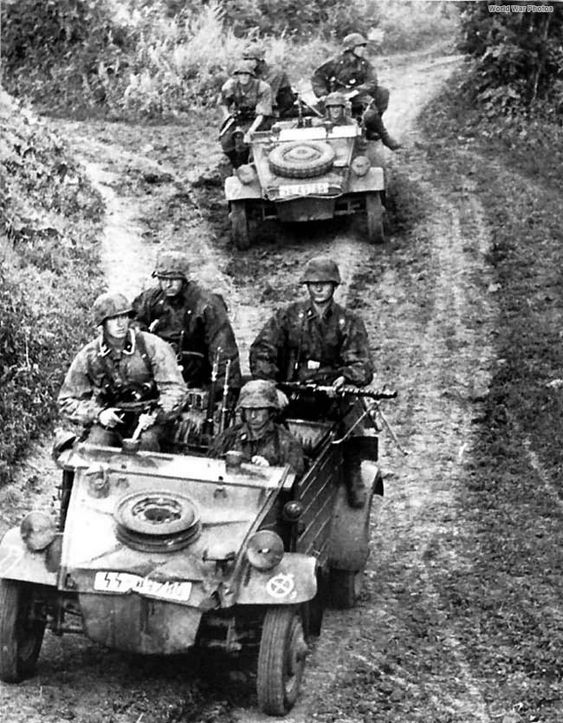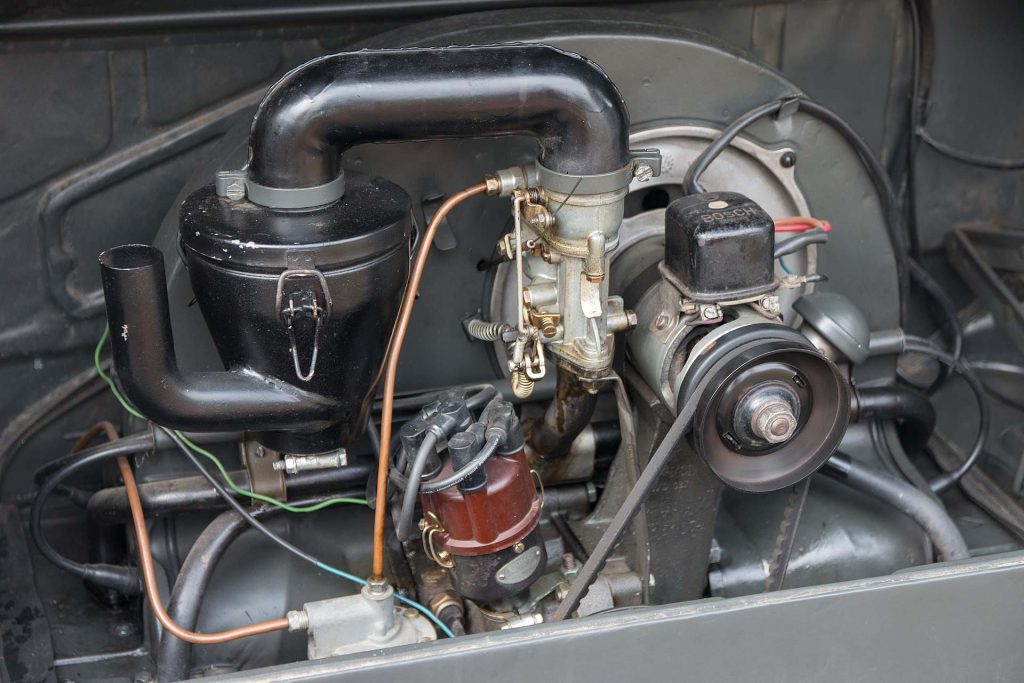The Volkswagen Type 82, commonly referred to as the Kubelwagen, was a motor vehicle developed for the Wehrmacht. Its design was based on the KdF-Wagen.
Between August 1940 and April 1945, the Volkswagen factory near Fallersleben produced a total of 50,788 units in various versions of the Type 82. Following the conclusion of the war, production of the Type 82 continued briefly using leftover parts, during which it was known as the Type 21.
In 1936, the initiative to transform the civilian Volkswagen 60 into a military vehicle commenced. This project aimed to create a vehicle that could transport four individuals along with their equipment. The first prototypes emerged in 1938, capturing the interest of the German army, which subsequently selected one of the models.
Contents
Production started promptly, and by December 1939, the first unit was in service with the German army. Officially designated as the “Kübelsitz-wagen” model 82, it was soon colloquially referred to as the Kübelwagen by German military personnel.

The Kübelwagen quickly gained a reputation as a durable and robust vehicle, adept at navigating various terrains. From 1940, two additional versions were produced: one tailored for arid environments and another for extremely cold conditions. Throughout World War II, close to 55,000 units of the Kubelwagen model 82 were manufactured.
Read More: German S-mine was Shrouded in Secrecy
Several other variants of the Kubelwagen were also developed, including the model 155, which was converted into a half-track vehicle, the armored model 163, and the model 166 (Schwimmwagen), an amphibious vehicle.
Design
The origin and development of the Kubelwagen, a key military vehicle of World War II, is a story deeply entwined with the ambitions and technological advancements of Nazi Germany in the late 1930s. Its conception was driven by the Wehrmacht’s need for a lightweight, versatile, and reliable utility vehicle, suitable for the diverse range of environments and conditions expected in the upcoming conflicts.

The design and production of the Kubelwagen were entrusted to Ferdinand Porsche, a name already associated with innovative automotive design. Porsche and his team were at that time engaged in the development of the Volkswagen Beetle, a project initiated and heavily promoted by Adolf Hitler as part of his vision for a “people’s car” (Volkswagen).
The Beetle’s design principles – simplicity, reliability, and affordability – were to heavily influence the development of the Kubelwagen.
Read More: Exploring the R612 Bunker on Utah Beach
Porsche’s approach to the Kubelwagen was to adapt and modify the existing chassis and mechanical systems of the Beetle. This decision was not only cost-effective but also strategic, as it allowed for the sharing of parts and maintenance knowledge between the civilian and military vehicles.
Rear-Wheel Drive
The result was the Type 62 prototype, which, after rigorous testing and modifications, evolved into the Type 82 – the definitive Kubelwagen model.
The vehicle’s design was a study in functional minimalism. Unlike the complex four-wheel-drive systems used in other military vehicles of the time, the Kubelwagen was rear-wheel drive. This simplicity was intentional, reducing potential points of failure and easing maintenance. The body was also a departure from traditional military vehicle designs.

It featured a lightweight, flat-paneled, open-top structure, allowing for easy ingress and egress, and was fitted with bucket seats – lending the vehicle its name, “Kubelwagen,” which translates to “bucket car.”
In terms of performance, the Kubelwagen’s adaptation to various terrains was initially a concern, given its rear-wheel drive. However, Porsche’s innovative design, which included a lightweight build, a robust flat-four air-cooled engine (similar to the Beetle’s but more powerful), and a ground clearance higher than that of contemporary American Jeeps, allowed the Kubelwagen to excel in various operational theaters.
Read More: The M1918 Browning Automatic Rifle (BAR)
Its torsion bar suspension, a feature borrowed from the Beetle, provided a level of comfort and off-road capability that was unexpected for such a basic vehicle.
The Kubelwagen’s development was a reflection of the German military’s broader strategy at the time: to produce equipment that was not only effective but could be manufactured quickly and in large quantities. The vehicle’s shared lineage with the Volkswagen Beetle was a key factor in achieving this, allowing for the rapid ramp-up of production and the efficient use of resources – critical factors in the early years of World War II.
Technical Features
Ferdinand Porsche’s design philosophy, emphasizing straightforward and robust engineering, was evident in every aspect of the Kubelwagen’s construction.
Central to the Kubelwagen’s design was its engine. The vehicle was powered by an air-cooled, four-cylinder boxer engine, very similar to the one used in the Volkswagen Beetle. This engine was small, yet surprisingly powerful for its size, providing adequate torque for the lightweight vehicle.

The air-cooled nature of the engine was a significant advantage, especially in extreme environments. It eliminated the need for a radiator, making the Kubelwagen less vulnerable to bullet damage and leaks, and reducing maintenance requirements. Furthermore, the absence of liquid coolant meant that the Kubelwagen could operate in freezing conditions without the risk of the coolant freezing, a common problem with water-cooled engines.
Read More: Helge Meyer, ‘God’s Rambo’ & his ‘Ghost Car’
The vehicle’s drivetrain was also a point of interest. While most military vehicles of the era opted for four-wheel drive for better off-road capability, the Kubelwagen used a simpler rear-wheel drive setup. However, this did not substantially hinder its off-road performance.
Suspension System
The vehicle was equipped with a self-locking ZF differential, giving it better traction on rough and uneven terrain than a typical rear-wheel-drive vehicle. Additionally, its lightweight build, combined with a high ground clearance, allowed it to traverse obstacles and terrains that would immobilize heavier and more complex vehicles.

Suspension was another area where the Kubelwagen excelled. It used a torsion bar suspension system, which was more compact and lighter than traditional leaf-spring systems. This type of suspension provided a smoother ride over rough terrain and contributed to the vehicle’s overall agility and stability.
The Kubelwagen’s body design also complemented its technical capabilities. Its flat body panels and angular design were not just for ease of manufacturing; they also allowed for better maneuverability and visibility.
Read More: Schwimmwagen the Iconic ‘Boat on Wheels’
The open-top design, although a vulnerability in combat situations, offered quick and easy access for troops and equipment. Additionally, the vehicle’s relatively low weight allowed it to be more fuel-efficient and faster than many contemporary military vehicles.
The Kubelwagen’s technical features and performance characteristics were a testament to the ingenuity of its design. Its engine and drivetrain were optimized for reliability and ease of maintenance, crucial for operations in the diverse and challenging environments of World War II.
The suspension and body design contributed to its notable off-road capability and operational versatility. All these factors combined to make the Kubelwagen a highly effective military vehicle, despite its apparent simplicity.
Kubelwagen in WW2
The role of the Kubelwagen in World War II was both extensive and multifaceted, illustrating its versatility and reliability as a military vehicle.
During the conflict, the Kubelwagen was deployed across various fronts, playing a crucial role in the operations of the German Wehrmacht. Its presence was felt from the scorching deserts of North Africa to the frigid expanses of the Russian Front, and in the many varied landscapes of Europe.
In the North African campaign, the Kubelwagen’s air-cooled engine proved to be a significant advantage. Unlike water-cooled engines, which were prone to overheating and clogging from sand and dust, the Kubelwagen’s engine was more resilient in the desert environment.

Its lightweight construction allowed it to maneuver through sandy and rocky terrain more effectively than heavier vehicles. This adaptability made it an essential asset for the Afrika Korps, where mobility and speed were vital in the vast expanses of the desert.
Read More: Pegasus Bridge, Many Legends Were Made
On the Eastern Front, the Kubelwagen faced entirely different challenges. The harsh Russian winters were notorious for immobilizing mechanical equipment. However, the Kubelwagen’s simple, robust design and air-cooled engine allowed it to operate reliably in extreme cold, where other vehicles often failed.
Reconnaissance
Its high ground clearance was beneficial in navigating through snow, mud, and rough terrain, making it invaluable for the German forces operating in these challenging conditions.
In Western Europe, the Kubelwagen was a ubiquitous sight, used for a wide range of purposes. It served as a personnel carrier, a dispatch vehicle, and sometimes even as an ambulance. Its versatility was further demonstrated in its occasional use as a platform for light weapons.
The vehicle’s open-top design, while a drawback in combat situations, offered excellent visibility and ease of communication, essential for reconnaissance and liaison roles.

The production of the Kubelwagen was ramped up as the war intensified, reflecting its importance to the German war effort. Over 50,000 units were produced during the conflict, making it one of the most common German military vehicles of World War II. Its ubiquity on the battlefield was a testament to its effectiveness and the high regard in which it was held by the German military.
Read More: The Vespa 150 TAP Anti-Tank Scooter
The role of the Kubelwagen in World War II was integral to the operations of the German military. Its deployment across diverse and challenging environments showcased its adaptability and resilience. From the heat of North Africa to the cold of the Russian front, and in the varied landscapes of Europe, the Kubelwagen proved to be an invaluable asset, contributing significantly to the mobility and logistical capabilities of the German forces during the war.
Kubelwagen Post War
After World War II, the Kubelwagen left a significant mark, both in military contexts and in the broader automotive world.
In the immediate aftermath of the war, surplus Kubelwagens were repurposed and used by various military and civilian entities. Allied forces, notably, found uses for captured Kubelwagens, employing them for various utility purposes due to their reliability and ease of maintenance. This extended use by the victors of the war is a testament to the vehicle’s practical design and robust construction.

Moreover, the Kubelwagen’s influence extended into the development of post-war military vehicles. Its simple yet effective design principles, particularly its lightweight structure and efficient air-cooled engine, informed the development of several post-war military utility vehicles.
Notably, the United States’ M151 MUTT, which saw extensive use in the latter half of the 20th century, bore design elements reminiscent of the uübelwagen.
Read More: Schwerer Gustav Was the Largest Gun Ever Made
The civilian automotive industry also felt the impact of the Kubelwagen’s design. The vehicle can be seen as a precursor to the modern SUV and off-road vehicles. The concept of a lightweight, versatile, and terrain-capable vehicle, as embodied by the Kubelwagen, was an idea that held appeal beyond military applications.
Symbol of WW2
This led to the development of civilian off-road vehicles that shared many of the Kubelwagen’s characteristics, such as air-cooled engines, high ground clearance, and a focus on utility and reliability over luxury.

In popular culture, the Kubelwagen has maintained a presence as a symbol of World War II and German military engineering. It appears in historical documentaries, films, and reenactments, serving as a reminder of the technological advancements and challenges of that era.
The post-war legacy of the Kubelwagen is marked by its continued use, influence on vehicle design, and cultural significance. Its transition from a wartime necessity to a peacetime utility vehicle and its impact on the design of both military and civilian vehicles underscore the lasting impact of this simple yet effective military vehicle. The Kubelwagen’s story is not just one of war; it is also a narrative of how innovation in times of conflict can lead to broader advancements in technology and design.






